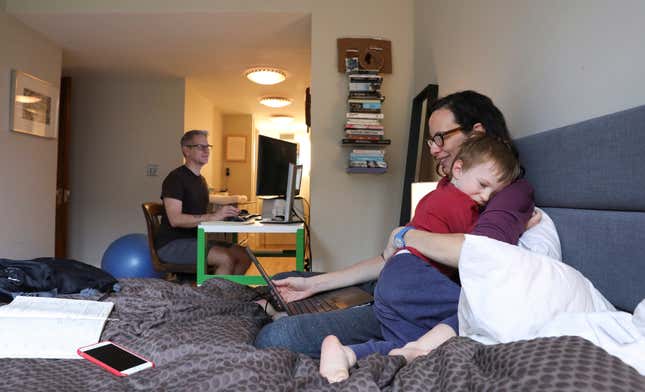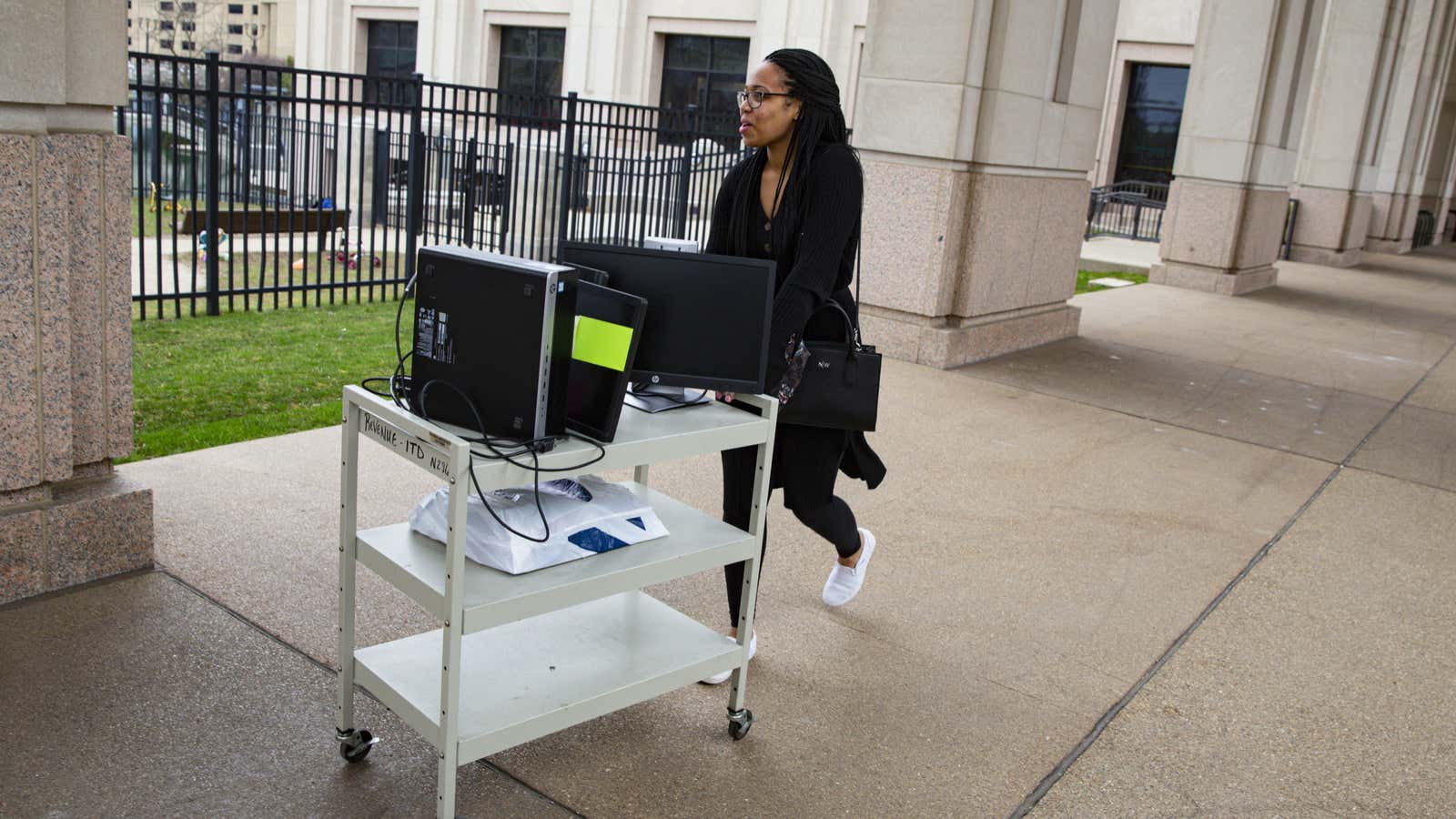When the Covid-19 pandemic winds down, it will have left an indelible mark on the workplace.
Already, millions of people around the globe are learning to work from home, and figuring out how to stay productive and connected as they do it. Paid sick leave in countries like the US, which never mandated it before, has become a front-burner issue. More employers than ever are talking about mental wellness, and are understanding now that work-life balance has always been a facade.
What downstream effects will this have on corporate culture, or creativity, or personal wellbeing? Quartz talked to CEOs, consultants, and other workforce authorities about what we stand to gain and lose from the changes wrought by the coronavirus crisis—and what’s impossible to predict.
Table of contents
What we may gain | What we may lose | What’s too soon to call

What we may gain
Diversity in rank and file | Fairness | Benefits for gig workers | Newfound flexibility | Better home offices | Literal savings | Improved cultural norms | Trust | Clarity of purpose
Diversity in the rank and file
Perhaps the most alluring promise of a more permanent shift to a majority-remote workforce is that it could lower some of the barriers to building a truly diverse company.
Darren Murph, head of remote work culture at GitLab, a remote-only online software development platform, is a believer in this theory. It’s not only caretakers—often women who take on the majority of child or eldercare at home—that stand to benefit, he says. For example, “you have people with disabilities or illnesses that they might not even be comfortable sharing.”
We make compromises when we go into an office, where all the cubicles are set up the same way and there’s little privacy. GitLab allows people to spend company money to set up a custom workspace, “to buy equipment that you need to make yourself healthy and comfortable,” he says.
Remote teams with members scattered across countries are often also diverse in race and culture, and representative of geographic regions around the world. GitLab employs people in 65 countries, and their radically different ways of living are all enticingly visible in the background of Zoom calls. In comparison, Murph says, “if you took a company that was based in Seattle and you say, ‘Alright, we’re going to hire a few people from every country in the world and relocate them to Seattle,’ then within six months, they’re all Seattleites. They have American politics, American public transit, American money, American cell phones.”
Varied perspectives inevitably shape the products a company makes or the services it offers. They influence the way a company operates across different markets, too, in ways that could not be possible if the team was tethered to one office.
Job opportunities in tech in particular tend to be concentrated in coastal cities with high costs of living, which is one reason the industry has had a hard time attracting a more diverse workforce. In recent years, some companies have started to go completely remote in part to recruit talent outside of the major tech hubs. The crisis may help accelerate that.
Wade Foster is a co-founder of the productivity software company Zapier, which was founded in 2011 and has a fully distributed workforce of more than 300 people across 27 countries including, Vietnam, Brazil, France, and Croatia. He says the employees who best adapt to remote work are self-starters with good communication skills, which are essential when a remote team is distributed across multiple time zones. But he adds that workers can adapt and learn how to work remotely.
Fairness
In recent weeks, companies have been forced to grapple with the widening inequalities within their workforce, tweaking policies to better serve front-line workers who don’t have benefits like paid time off or the ability to work from home. But will these companies continue to offer these services post-crisis?
“I’d like to think that some major corporations and decision makers will insist upon paid sick leave going forward—not just in a crisis,” says Terri Gerstein, a project director at Harvard’s Labor and Worklife Program. “I think also once [businesses] implemented paid sick leave as an emergency measure, there’s some kind of proof of concept where they can see that it’s actually manageable.”

Research shows that paid leave doesn’t necessarily help businesses—but it doesn’t hurt them either. The crisis is an opportunity for companies to show they value their employees’ well-being. Workers who are ill and have no choice but to go to work can put others at risk.
“There’s much more of a visceral…intuitive understanding of the fact that paid sick days are not just a workers’ rights issue— but also a public health issue,” Gerstein says.
When companies implement paid sick leave and paid family leave from the start, they will have an easier time implementing these systems when an emergency happens, she adds. The reverse might also turn out to be true.
Benefits for gig workers
The crisis also underscores the problems with business models that depend largely on the gig workforce.
Historically, benefits were designed to be employer-sponsored and tailored to traditional employment. They generally don’t apply to contract workers, a point that even Uber CEO Dara Khosrowshahi—who oversees a fleet of workers not entitled to benefits—felt compelled to point out to US president Donald Trump in a March 23 letter requesting more emergency federal support for independent contractors.
In the future, there could be more “coalition-type of organizations” where companies say we can’t be your employer, but we can pool our resources to buy benefits and share those costs, suggests Yong Kim, CEO of Wonolo, a staffing platform that connects contingent workers to companies like Walmart, Uniqlo, and Coca-Cola.
“This paradigm shift is here to stay, this rising workforce is going to continue to grow,” he says. “All the benefits and services that are designed for the traditional employees—can we design it to follow the workers instead of the companies?”
Newfound flexibility, even among the old guard
Predictions about how long we’ll be living with the fallout of the coronavirus crisis vary from about a year to 18 months, when a vaccine should become available. But some believe we’ll be dealing with spontaneous quarantines to contain fresh outbreaks of Covid-19 and other viral threats long past the resolution of this pandemic.
GitLab’s Murph is confident that this first wave of at-home working en masse will be enough to permanently change the work-from-home narrative. He’s willing to bet that many employers won’t go back to the co-located company model after seeing how a distributed workforce system reduces a firm’s exposure to unpredictable public health risks, political disruptions (such as Brexit), natural disasters, or climate crises.
He’s also certain that employees won’t continue to tolerate inflexible policies. Covid-19 has given remote work the momentum it needs to become a fixture for every company. “Once you have a taste of that freedom and flexibility, once you feel like this is what life could be like if I don’t commute two hours every day, once your family gets a taste of that, it’s really difficult to say, ‘Okay, so for the same title, for the same salary, for the same everything, I’m going to further complicate my life” with a commute.
He envisions a “massive awakening,” now that it’s not just a handful of folks who have carved out special work-from-home arrangements with their managers. “When you have 100,000 people at Google jointly doing this, there’s going to be entire teams that say, ‘Hey, we work really well asynchronously, living and working in a place that’s comfortable and convenient for us. How about we just not go back unless it’s, like, an absolutely essential meeting?”
Better home offices
In response to the crisis, some companies have been offering employees a stipend for home set-up. Shopify, which employs about 5,000 people worldwide with a majority of its staff in Canada, is offering employees a $1,000 stipend to buy office supplies to help ease the transition of working remotely. Facebook is offering employees free Portal video chat devices to employees.

Up until now, only about a quarter of employers have been paying for home-office technology, according to research firm Global Workplace Analytics. Those that do, on average, offer stipends of $500 to $2,000.
Foster says that at Zapier, some employees use co-working spaces, but most prefer to work from their own home. “They’re able to work more efficiently using the desk setup they prefer,” he says. “Many of our teammates don’t want to work at a co-working place unless they have another co-worker there.”
In the future, more companies may adopt a hybrid model, with a physical office where new hires can get onboarded and work from initially, and remote setups for employees who need or prefer it, according to Dave Berndt, senior human resources advisor at HR outsourcing services G&A Partners.
Literal savings
Though the bottom-line impact has been mixed, a big incentive for companies to go remote is the prospect of reduced costs. “A lot of employers now are saying, ‘So maybe I don’t need 50,000 square feet in downtown New York. I can get away with 30 and have people work remotely,’” says Johnny Taylor Jr., CEO of the Society of Human Resources Managers (SHRM).
One recent estimate from the research firm Workplace Analytics says companies can slash their real estate bills by an average of $11,000 per half-time telecommuter per year, while benefiting from the increased productivity and lower worker turnover tied to remote work. According to the firm’s calculations, based on average US compensation, a company would break even on a $1,000 home office stipend in about two days of working at home. (Though, remote work doesn’t necessarily equate to lower costs.)
Employees themselves, meanwhile, can save between $2,500 and $4,000 a year with half-time work-at-home, according to Workplace Analytics. The savings are not just financial. The reduction in commuter travel is equivalent to 11 workdays per year of free time.
Cultural norms supporting rest and balance
There have long been calls for employers to pay more genuine attention to wellbeing and balance in the workplace—not for the sake of keeping employees productive, but to allow people time to rest and protect their health. Advocates of this approach hope that employers will heed the lessons of the coronavirus pandemic, even after life returns to “normal.”
Dawna Ballard, a communications professor at University of Texas at Austin and a scholar of chronemics, the study of time and communication, says the pandemic is already prompting deeper reflection about where we put our energy and why. “The work culture of sleep deprivation as a means of increasing productivity not only leads to lower-quality work outcomes—including mistakes, presenteeism, and industrial accidents—but it also decreases our immune systems,” she says. Anyone who has already been practicing good sleep hygiene, rather than heeding the call of zealot CEOs pressing employees to work through “crunch” times, will fare better, she says.
Presenteeism, as a reminder, is defined as showing up at work for the sake of being there, even when physical or mental conditions make productivity next to impossible. Covid-19 is exposing how widespread presenteeism is in developed countries, Ballard says, especially those like the US, where paid sick leave is unavailable to millions who work in retail, restaurants, hotels, and other service jobs, or in India, where 90% of the workforce is in the informal economy.
Yet, even employees with full benefits have been known to not take sick days, often out of a fear of appearing less committed to their employer. “The norm of showing up to work even when we’re sick and exposing others has always spread illness,” Ballard says. “Many people don’t have a choice because of job insecurity, low wages, and the absence of sick leave. For others it is driven by a limited view of productivity and focused on identity issues—[but] what seems to work in the short-term and for one individual may have dire consequences on the collective and on long-term productivity.”
Trust
If you’ve already been working at home, at least partially, you might take for granted by now that your manager trusts you to complete your tasks and stay engaged with company matters as much as you would when surrounded by colleagues at the office.
But think back to that first time you asked for permission to work from home, and you just might remember your boss’s reluctance, or at least a sense that you’d have to prove you’d be productive. That’s still a common dynamic at companies where flexible work policies remain relatively untested. Art Langer, executive director of the Center for Technology Management at Columbia University, believes the coronavirus pandemic is going to force managers to reckon with their suspicious minds.
The kind of trust he expects managers and c-suite leaders to foster won’t stop at accepting that individuals are behaving like reliable adults in their home offices, but also that employees can be granted more autonomy to manage and strategize without top-down oversight. “You have to be willing to have more trust in giving people responsibilities and giving them the ability to perhaps fail.
Clarity of purpose
Only two months ago, Quartz reported that the 2020 World Economic Forum, aka Davos, had a clear winner: corporate stakeholders beyond the investor base. The galvanizing theme at the meeting in the mountains: that the purpose of a company is to serve the economic and practical needs of not just shareholders, but employees, suppliers, the community, and the environment.was indisputable.
Little did anyone know (or perhaps recognize fully) then that Covid-19 would soon push companies to act on this ethos, The pandemic has forced firms to confront pay and benefit inequities within their own ranks, and to acknowledge the precarious nature of part-time or contract positions. It also has prompted companies with the means to give expertise, equipment, and funding, and to produce medical equipment and diagnostic tools to save lives.

This month, Ford, GM, and 3M announced a plan to combine forces and tretool Ford parts to make ventilators, respirators, and equipment that doctors and nurses need to stay safe as they care for Covid-19 patients. Rolls Royce and Dyson engineers in the UK have also turned their attention to the dire demand for ventilators, while LVMH’s perfume factories pivoted to making hand sanitizer. In New York, the Four Seasons Hotel is offering free rooms to doctors, nurses, and medical staff. Even credit card companies are waiving fees and payments, in some cases. And Silicon Valley companies are abuzz with ideas (and characteristic hubris) about data-informed contact tracing, spread modelling, and drug-testing.
Government mandates and stimulus packages are connected to some of these unprecedented undertakings, but in many cases, companies are donating what they can and retooling their goods when there’s little to be gained financially from the shift, and much to offer humanity.

What we may lose
Diversity in leadership | A democratic culture | Conferences | Social connection | Employee activism
Diversity in leadership
As tempting as it is to imagine that ramping up remote work will only open the doors to more diverse groups of people—see above—that may not be the whole story. Taylor, the SHRM head, wants companies to start thinking about the unintended consequences of a work-from-home revolution. There’s a reason we say “out of sight, out of mind,” he cautions.
Taylor’s concern is rooted in what we know about human behavior. “Let’s say a disproportionate number of women start telecommuting or working remotely as a result of not just coronavirus, but period,” he proposes. “Our research tells us that promotional decisions, work relationships are built face to face. Fast forward 10 years from now, fewer women are in management positions because they don’t have the opportunity on a daily basis to interact with not just men, but other women who are going to be making those decisions.”
Leaders promote the people they see, the ones they chat with in the elevator, he says. There could be a prime candidate for a leadership role, Taylor suggests, but “the person has been working in their remote office, doing a phenomenal job, but no one knows it because you have no interaction with them.” Right now, c-suite roles across industries are dominated by white men and they are the ones who will be deciding how all of this works, he notes.
As an African-American man, he is nervous, he says. He wants to see more intentionality around trying to figure out the right balance between remote and co-located work, whether it’s ensuring everyone is available for meetings on a particular day or limiting the number of days people work from home to two or three per week. “I think we’re trying to figure out how to walk into this new normal,” he says, “and not potentially lose traction around the things that matter around diversity and pay equity, et cetera.”
A democratic culture
Although it’s early days in the coronavirus response, we’re already seeing how quickly people can take both free-form comradery and structured rituals online. Friends are holding online dance parties and drag shows, and colleagues are holding impromptu coffee meetings or breaks for stretching. Company town halls and weddings are moving to streaming. So, yes, to be sure—much of what creates a company’s culture, whether it’s fun-loving and supportive or dictatorial and buttoned-down, can be recreated digitally in a distributed model.
However, says Ben Waber, president and co-founder of the workplace analytics firm Humanyze, the one form of communication that’s least likely to survive the move to online in the coming months is that which flows directly between top leadership and employees or managers on the front lines of a company. “Right now, you’re not going to Slack the CEO, ‘Hey, can I talk to you?’” he says. “You could, but data says it doesn’t happen.”
Massive multinationals with thousands of employees already need to work to keep leadership connected, a key ingredient in building a resilient company, and one in which employees feel engaged and respected. To do that when employees are cloistered in their homes instead of roaming around the hallways and lounging at the metaphorical water cooler, a leader would need to reach out to random people online, says Waber. “Managers would have to say, ‘Let’s have a chat over Zoom or have lunch over Zoom,’” he adds. “It goes a long way, and it requires effort and planning to properly replicate what happens naturally in a physical workplace.”
Learning (and solidarity) at IRL conferences
The coronavirus crisis has —at least temporarily—brought the conference business to its knees. That may not seem like such a loss if you’ve become disenchanted with overproduced keynotes, souped up with light shows and booming entrance music, or long lines for lukewarm convention-center lunches. But conferences do serve a couple of noble purposes—namely, and most obviously, they allow a person to learn and develop skills in their trade by accessing experts outside of their own company. Networking at big events can also build solidarity among people who share a profession (or another identity). Most of us became teachers, communicators, coders, or designers because we were drawn to the craft, not a single corporation.
Online conferences can replicate the learning experience, but it remains to be seen whether virtual conferences—which may become more mainstream, should there be a lingering fear of large gatherings in the future—can allow people the same opportunities to network across an industry and collectively discuss, say, the ethics or goals of a profession or trade. But the same principle that makes SHRM’s Taylor weary of remote work’s effects on diversity in leadership also applies here: Relationships are strongest when they’re supported by in-person encounters.
Social connection
While remote work may bring a lot of benefits, there’s the potential loss of social connection. “It’s more difficult for the employee to really feel like they’re part of the company culture,” says Berndt at G&A Partners. “It’s just much harder when you’re not rubbing shoulders with people day-to-day.”
The reality is that not everyone will be suited for this environment. Those who rely on work for a social life, for instance, may not find the autonomy to be a good fit for them, according to Zapier’s Foster. Employers with a strong sense of purpose, mission, and community will become ever more important in making workers feel connected. “[Leaders] need to figure out the communication and information pipeline, so people in the company know what to focus on,” says Berndt. “If not, work will feel chaotic.”
Employee activism
If 2019 was the year that employee activism ascended, this may be the year that calls for regrouping and rethinking strategies. In theory, a new normal in which workers are distributed shouldn’t faze activist employees at places like Amazon and Google, who were already communicating and organizing with colleagues abroad through digital channels.
Social media platforms and shared online documents or spreadsheets make achieving critical mass in digital campaigns relatively frictionless. However, scholars also know that in-person gatherings build the strongest connections over time and may be necessary for a movement to be transformative. Besides, some goals of activist projects already feel less urgent, with the obvious exception of those that protect jobs and income.

The unknowns
Productivity | Creativity | Telemedicine benefits | Sustainability | Separation between life and work
Productivity
To plunk productivity down on either side of this ledger would be controversial, especially now, when millions are still adjusting to working from their living rooms, while minding kids home from school, and following coronavirus developments. For now, people are probably getting less done, and we simply don’t know where productivity will land in a few months. Humanyze’s Waber believes a lot of companies will struggle and make costly mistakes.
Waber stands firmly in the camp that discourages too much working from home, reserving that practice for periods when uninterrupted focused work is required, not close collaboration. Granted, his products gather data on organizational networking in real time within physical spaces. But Waber also points to data, like one study that found remote developer teams took 32% longer to complete a coding project compared to developers who were under the same roof.

The lost time comes down to missed opportunities for communication, he believes. When you bump into colleagues across departments, you can informally share information that you may not know to seek out online. Or imagine you’re working on a project and you’ve hit a snag. In an office building, you might spot someone who can hover at your desk for less than a minute while you together solve the problem, he says. Some questions seem too trivial for a scheduled meeting, but they take far longer to answer when a team is all remote. Famously, IBM and Yahoo have both reversed work-from-home policies believing their engineers got more done face to face.
Leaders at all-remote companies would protest. GitLab’s Murph says that when you need to solve a problem at a company where everyone is remote, you can instantly see online whether someone you need is available, for example; no taking a trip across an office or to another floor to meet for an issue you can settle with a quick message exchange. He also has team members who keep a Zoom link open all day, making spontaneous conversations and quick huddles possible.
Arguing that a distributed workforce is less innovative or productive is illogical when there’s no baseline data with which to make an objective comparison, Murph insists. But there’s actually some data in his corner, too. One recent survey of 1,004 full-time employees found that remote employees actually worked 16.8 more days per year than employees who went into an office, according to self-reported responses. A larger study led by Stanford economic professor Nicolas Bloom, and published in 2015, found a 13% increase in performance among employees who worked from home at a Chinese software company.
Creativity
Does remote work help boost creativity? Some remote work leaders believe you can have spontaneous collisions when everyone is working from home. “When people are forced into this model, it will unleash a lot of creativity,” says Zapier’s Foster. He takes an optimistic approach: People who work remotely and want to fix a certain problem will do so by building a solution.
On the other hand, being completely remote can have its downsides. Stanford’s Bloom told Vox that most creativity is done in face-to-face environments—and that being around people is what encourages you to be ambitious and motivated. “Full-time at home can be pretty miserable,” he says.

Research shows that an autonomous environment can help enable creativity, but the research is also limited. Another study, from 2012, found that telecommuting may boost productivity of creative tasks but have negative implications on the productivity of dull tasks. That suggests that workers in more creative roles may have a better advantage in a remote environment.
Telemedicine benefits
Telemedicine, a benefit now commonly bundled with health insurance plans, has been woefully misunderstood and underutilized for years, says Liz Supinski, SHRM’s director of research products.
It’s easy to list all of the reasons employees should have embraced it, even before the coronavirus pandemic began. Telemedicine is convenient, eliminating travel time and costs. It’s ideal for communities where there are a limited number of doctors. It’s cost effective for employers and employees, especially for those whose circumstances mean they often rely on urgent care or emergency rooms. Finally, it’s a practical solution for chronic illnesses, says Supinski.
Now, in the context of a pandemic, telemedicine also keeps the sick away from clinics and people, and creates a space where physicians who, for whatever reason, need to self-isolate or work from home (perhaps to care for quarantined children) can still “see” patients.
At last, telemedicine does appear to be having a moment, Supinski notes. In the coming months, we’ll see whether it will hold up or collapse under pressure, she predicts. Should it fail, and there are already signs of strain, it could be years again before we see its widespread adoption. More optimistically, millions of people could finally recognize its immense value and understand much telehealth has advanced since its debut.
Sustainability
On the surface, it appears that working from home would be a win for the environment and any companies that are trying to reduce their carbon footprint. However, the amazing pollution-free skies and clear Venetian canals we’re seeing in media reports have to do with reduced manufacturing and mass travel tourism, not less commuting or energy usage on the part of knowledge workers.
Indeed, when it comes to the environmental impact of working from home, the numbers can be mixed. On the one hand, being at home and constantly online might bump up your energy usage compared to when you’re in and out of face-to-face meetings. Then again, a recent study from the UK found that, in winter months, modern offices are more energy-efficient than individual homes, the BBC reports. In the US, meanwhile, innovations that have improved energy usage in office towers probably make it greener to go and sit in the cool air at work than to stay home and flip on your air conditioner.
The environmental cost of driving to work varies by country, too, as some nations have raced ahead with electric car adoption and others haven’t. In short, it appears there are too many variables in play to make one blanket statement about whether a more remote workforce is better or worse for the planet.
Separation between life and work
Going remote means more dependence on technologies such as messaging tools like Slack, which can contribute to the “always on” culture. Productivity might suffer if workers can’t figure out the right work-personal life alignment.
Zapier’s Foster says that managers may be worried about their teams not working enough but, in reality, it’s the opposite problem. Oftentimes, remote workers work even longer hours than they’re supposed to. “Most of the expectations to be online 24/7 is self-inflicted,” he says.
Companies that go remote will need to recognize that managers need to be retrained. “The old school type was managing people in chairs,” says G&A’s Berndt. “Managers might not be as comfortable managing somebody they don’t see on a regular basis.” Leaders will need to make explicit to their employees that it’s OK to take time off, to walk away, and unplug when needed.
Correction: An earlier version of this article misspelt Terri Gerstein’s name.
